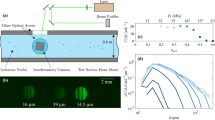Abstract
Water susceptibility and background nuclei content in a water tunnel are investigated using a cavitation susceptibility meter. The measured cumulative histogram of nuclei concentration against critical pressure shows a power law dependence over a large range of concentrations and pressures. These results show that the water strength is not characterised by a single tension but is susceptible to ‘all’ tensions depending on the relevant timescale. This background nuclei population is invariant to tunnel conditions showing that it is stabilised against dissolution. Consideration of a practical cavitating flow about a sphere shows that although background nuclei may be activated, their numbers are so few compared with other sources that they are insignificant for this case.


Similar content being viewed by others
References
Achenbach E (1972) Experiments on the flow past spheres at very high Reynolds numbers. J Fluid Mech 54:565–575
Arndt REA (2012) Cavitation research from an international perspective. IOP Conf Ser Earth Environ Sci 15(1):12,002
Chahine GL, Shen YT (1986) Bubble dynamics and cavitation inception in cavitation susceptibility meters. J Fluid Eng 108(4):444–452
Franc JP, Michel JM (2006) Fundamentals of cavitation. Springer Science & Business Media, New York
de Graaf KL, Pearce BW, Brandner PA (2016) The influence of nucleation on cloud cavitation about a sphere. In: 16th International Symposium on Transport Phenomena and Dynamics of Rotating Machinery (ISROMAC 2016), Honolulu, United States
Gindroz B, Billet ML (1994) Nuclei and propeller cavitation inception. FED Cavitation Gas-Liquid Flow Fluid Mach Devices 190:251–260
Khoo MT, Venning JA, Pearce BW, Brandner PA, Lecoffre Y (2016) Development of a cavitation susceptibility meter for nuclei size distribution measurements. In: 20th Australasian Fluid Mechanics Conference
Mørch KA (2007) Reflections on cavitation nuclei in water. Phys Fluid 19(7):1–7
O’Hern TJ (1987) Cavitation inception scale effects: nuclei distributions in natural waters, cavitation inception in a turbulent shear flow. PhD thesis, Caltech
Pham TM, Michel JM, Lecoffre Y (1997) Dynamical nuclei measurement: on the development and the performance evaluation of an optimized center-body meter. J Fluid Eng 119(4):744–751
Acknowledgements
The authors acknowledge the support of the Australian Defence Science and Technology Group.
Author information
Authors and Affiliations
Corresponding author
Rights and permissions
About this article
Cite this article
Venning, J.A., Khoo, M.T., Pearce, B.W. et al. Background nuclei measurements and implications for cavitation inception in hydrodynamic test facilities. Exp Fluids 59, 71 (2018). https://doi.org/10.1007/s00348-018-2520-5
Received:
Revised:
Accepted:
Published:
DOI: https://doi.org/10.1007/s00348-018-2520-5




